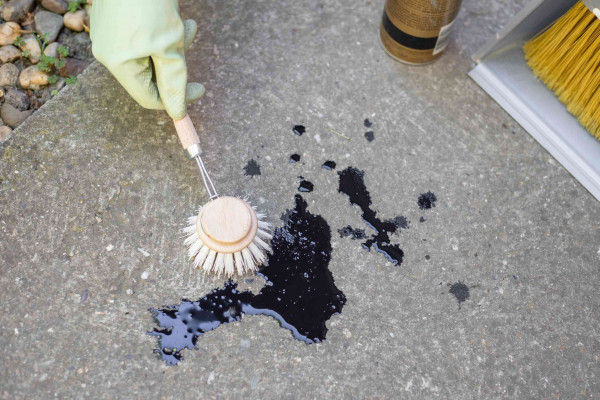Four Effective Ways To Remove Oil Stains From Concrete

Contaminants on the surface, such as oil, can affect whether or not your coating will be successful. If the oil is not cleaned, it will ultimately seep back through to the surface, destroying the new ornamental treatment you just applied. The difficulty of removing the stain will be proportional to both its size and how long it has been there.
When there is car activity in an area, oil stains are often inevitable. This includes concrete driveways and garage flooring. Other types of buildings, such as vehicle washes or wash bays, cooling towers, food processing industries, automobile repair shops, and parking garages, all have the potential to have oil stains on their floors.
When preparing the surface of the concrete for coating, the following are the four most effective techniques to remove oil from concrete:
1. Detergent
If the stain or spill is just superficial, it may be possible to remove it with little more than a powerful detergent, scrub brush, or sponge.
2. A Degreaser For Concrete
Scrubbing a commercial concrete cleanser and degreaser into the concrete surface is one option for cleaning it. They are heavy-duty concrete strippers and degreasers that are based on citrus, are simple to use, have a nice orange fragrance, and have low levels of volatile organic compounds (VOCs).
On the concrete surface, use the degreaser at its maximum concentration to eliminate stubborn dirt buildup, tire markings, oil spills, grease, hydraulic fluid, and any other pollutants that are difficult to remove. Twenty minutes should be enough time for it to seep into the surface.
Use a strong broom or floor buffer to work the degreaser into the floor (swing scrubber). After giving the floor a good washing, give it a thorough rinsing with water, and then either vacuum or squeegee it to dry. In the case of bases that are highly soiled and unclean, a second treatment can be required. Degreasers are often more effective on concrete that has a porous surface as opposed to concrete that has a hard or thick finish.
3. Poultice
An additional method for removing oil stains from concrete is to use a poultice, particularly for persistent spots that are tiny in size. You can make a poultice by first soaking absorbent material (such as kitty litter, pool filter media, or sawdust) in a powerful solvent (such as acetone, xylene, lacquer thinner, or MEK), then spreading the material over the stain. This will remove the stain.
Plastic wrap should be used to cover the poultice. The absorbent substance will pull the oil out of the concrete while the solvent will break down the oil. Take into consideration that this method is time-consuming, making it somewhat impractical for larger stains.
4. Microorganisms
Special single-celled microorganisms are the latest development in oil stain treatment technology. These are the same organisms that are used to clean beaches and rivers after massive oil spills. These microbes are capable of consuming crude oil and all of its byproducts. The organisms will perish once the oil has been completely consumed, leaving the concrete spotless and devoid of oil.
